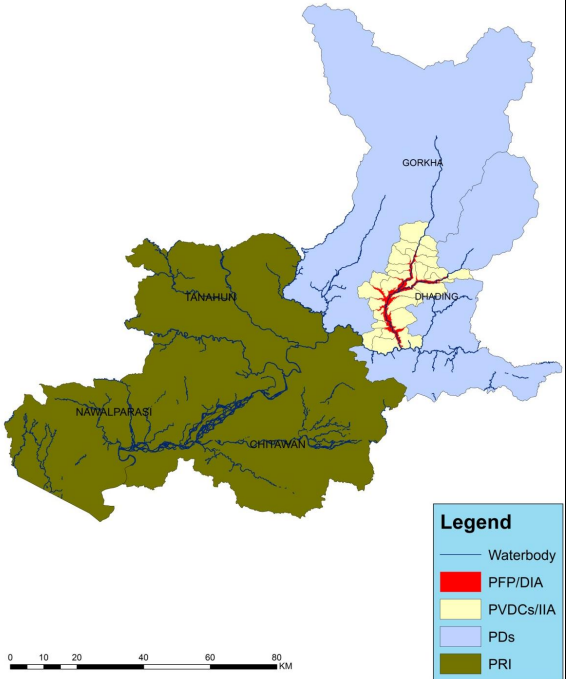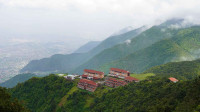Money
Budhi Gandaki hydropower project registered as public company
Successive governments have pulled the 1,200 megawatt scheme back and forth between them for decades, preventing it from getting off the ground.
Sangam Prasain
The long dormant Budhi Gandaki hydropower project took a step closer to starting construction with the government formally registering it as a public company with limited liability on Friday.
The establishment of Budhi Gandaki Jalbidhyut Public Limited has ended uncertainty and controversies over its financial and operational modalities, said Sunil Poudel, joint secretary at the Energy Ministry.
The 1,200 megawatt scheme, located in Gorkha and Dhading districts, is Nepal’s largest reservoir-type project and has a price tag of $2.6 billion. Construction is expected to last eight years.
The project which is envisaged to ensure energy security for Nepal for the next decades has been in limbo due to uncertainty over its funding modality.
Technicians identified the potential scheme during the Gandaki Basin Study in the late 1970s and did a pre-feasibility study in 1984. The storage-type hydropower project will store water in the rainy season and use it to produce energy in the dry season.
On June 29, a Cabinet meeting approved the Energy Ministry’s proposal to set up the company.
As per the proposed financial portfolio of Budhi Gandaki Jalbidhyut, the company will have Rs20 billion as authorised capital and Rs20 billion as issued capital, which is the value of the shares that will be offered to shareholders.
The company will issue 10 percent of the stock worth Rs2 billion to the project-affected people and another 10 percent worth Rs2 billion to the general public.
Of the remaining shares, the Energy Ministry will hold 50 percent, Finance Ministry 30 percent and state-owned power utility Nepal Electricity Authority 20 percent.
The amount agreed to be paid immediately by the founding shareholders is Rs16 billion.
“We will be opening an account and starting transactions soon,” said Poudel.
As the project will be developed under the new company now, there are some questions about the legality of the money that has been raised from the public to develop the Budhi Gandaki hydro project.
In May 2015, the government decided to impose Rs5 as a tax on a litre of petroleum products from consumers to develop the Budhi Gandaki project. According to Nepal Oil Corporation, more than Rs22 billion of revenue was collected under the Budhi Gandaki project heading.
In the fiscal year 2018-19, the then Finance Minister Yuba Raj Khatiwada changed the heading to infrastructure development tax being levied on petroleum products. The tax was also raised to Rs10 per litre.
As of now, nearly Rs100 billion has been raised as infrastructure development tax, according to Nepal Oil Corporation officials. The oil monopoly had also requested the government to give them a certain share percentage in the project if the tax continues to be imposed.
“The government did not respond to our request. We are legally entitled to get the shares,” said an official at Nepal Oil Corporation. “Now, with Budhi Gandaki being developed as a separate entity, what will be the status of the money raised from the public,” the officials questioned.

According to Poudel, as the project will be operated under the new company, there are many legal and financial issues to be settled.
“We will hold discussions to settle the issues. The government can provide the money in grants or invest in the company through other means,” he said, adding that nearly Rs50 billion has been spent on the project as of now.
This includes compensation for 48,900 ropanis of land acquired for the project.
The hydropower plant is located about 2 km upstream of the Trishuli-Budhi Gandaki confluence at the cross junction of the Gorkha and Dhading districts, about 80 km west of Kathmandu.
The first feasibility study was conducted in 1984 as it was viewed as being a mutually beneficial project for Nepal and India.
The project was first identified in 1978 by Snowy Mountains Engineering Corporation and was investigated initially for a 200 to 300-megawatt storage-based hydroelectricity project to meet the need for power generation in the mid-1990s.
A subsequent pre-feasibility study in 1984 recommended an installed capacity of 600 megawatts for the project with an average annual energy production of 2,495 GWh.
The project was re-evaluated by the Nepal Electricity Authority in 2010-11, after a gap of nearly 26 years. The final feasibility and detailed design study undertaken by Tractebel Engineering, France in 2015 proposed a 1,200 megawatt installed capacity with six Francis turbines each of 200 megawatts.
But the project did not come out of the drawing board until the second feasibility study was completed in 2014.
Nepal's most talked-about project has been pulled back and forth by successive governments, preventing it from getting off the ground for decades.
In 2017, the then Pushpa Kamal Dahal-led government awarded a contract to build the project without competitive bidding to China Gezhouba Group Corporation (CGGC) under the engineering, procurement, construction and financing (EPCF) modality.
The decision to award the contract to the Chinese developer was cancelled by the then Sher Bahadur Deuba government in November 2017, saying that there were some procedural flaws while awarding the contract.
Again in September 2018, the project became engulfed in politicking. The then KP Sharma Oli administration decided to rope in the Chinese company, reverting the Deuba government’s decision to develop the project with internal resources.
In April this year, the Sher Bahadur Deuba administration again decided to revoke the licence issued to CGGC to develop the project. Then the government announced that the project would be built by mobilising domestic resources.
Currently, the project has been estimated to cost $2.6 billion. But officials say the exact cost of the project could increase sharply due to inflation.
After the Deuba government scrapped the agreement with the Chinese company in November 2017, it floated plans to build the project using domestic financial resources via state-owned Nepal Electricity Authority.
Subsequently, a committee was formed under the then National Planning Commission vice-chair Swarnim Wagle to explore financing options to build the power plant.
The Wagle-led committee had suggested that the government develop the project on its own by providing viability gap funding, covering around one-third of the project development cost.
A Cabinet meeting during the Deuba administration approved the committee's report and agreed to provide the gap funding. But the plan never materialised as the government fell before the decision could be minuted.
The incoming administration under Oli, who had publicly criticised Deuba for scrapping the deal with the Chinese company, disowned his predecessor's decision.
The storage project will generate 3,383 GWh of energy annually.
The key project structure is a double curvature arch dam that rises 263 metres above the foundation. It will create a lake behind it to store water to turn the turbines of the 1,200-megawatt plant.




 6.94°C Kathmandu
6.94°C Kathmandu















